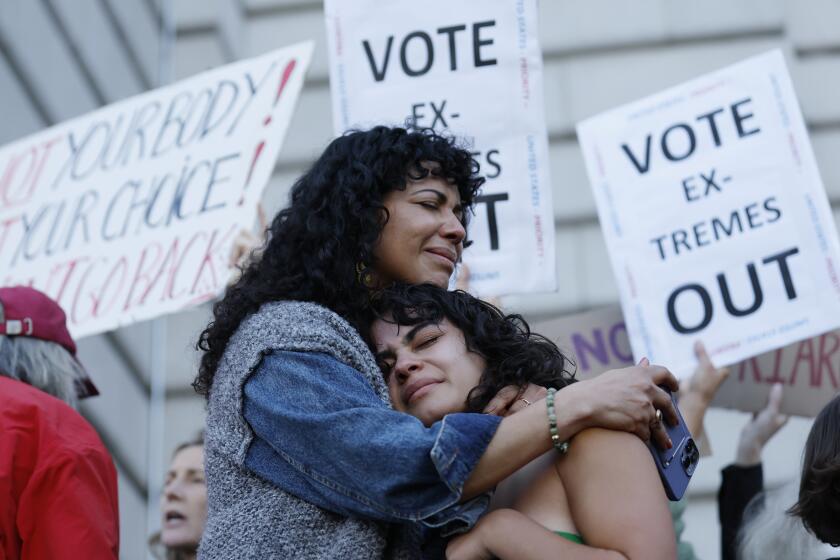Column: Republicans are ready to talk about racism. But only anti-white racism

It’s impossible to escape GOP propaganda about a war on white people.
Last month, former Trump aide Garrett Ziegler described the House Jan. 6 committee as a “Bolshevistic anti-white campaign.” Former House Speaker Newt Gingrich imagined a “cult of anti-white racism.”
Whereas the Republican Party once claimed it was “colorblind,” now it embraces race-conscious rhetoric. The era of Trump’s dog whistle has given way to Tucker Carlson’s explicit politics of white grievance.
Opinion Columnist
Jean Guerrero
Jean Guerrero is the author, most recently, of “Hatemonger: Stephen Miller, Donald Trump and the White Nationalist Agenda.”
The Fox News host ratcheted it up a notch last week by calling Democrats “openly and very aggressively anti-white” in a segment that complained about immigration and falsely conjured an open border.
These fantasies build on hysteria manufactured by right-wing grifters about “critical race theory,” maligned as “anti-white,” and assist the mainstreaming of white supremacist propaganda about immigrants “replacing” so-called “legacy Americans.”
In January, right-wing media consistently framed President Biden’s pledge to nominate the first Black woman to the Supreme Court as “racist” against white people. After Carlson falsely told millions of viewers that white people don’t qualify for the COVID-19 vaccine, Trump echoed him at a rally. “If you’re white, you don’t get the vaccine,” he said. (In fact, white people are overrepresented in getting vaccinated.)
Delusions of persecution among white people have fueled a surge in litigation, often invoking the Constitution’s equal protection clause. State efforts to respond to disproportionate COVID-related deaths among people of color by prioritizing them for antiviral treatments were thwarted by such lawsuits and legal threats, which have undoubtedly been lethal.
Other lawsuits have stalled attempts to address systemic racism as well, such as a Biden loan forgiveness program for historically marginalized farmers that was stopped by an injunction last year. Then there are two major lawsuits against affirmative action in college admissions that are before the Supreme Court and could reverse decades of civil rights progress.
Plaintiffs’ invocations of “equal protection” are a sham; the goal is not equality. Legal strategist Edward Blum, who orchestrated the affirmative action lawsuits, gets millions of dollars in support from DonorsTrust, a right-wing dark money organization that also donates to unapologetically white nationalist publications such as Vdare.
Blum was also behind the lawsuit that gutted the Voting Rights Act and others that challenged improved representation for Black and Latino voters as “racial gerrymandering.”
Another one of the most litigious groups in this space is America First Legal, led by the architect of Trump’s most racist immigration policies, Stephen Miller. His group sues to stop policies that promote racial justice by arguing that they discriminate against whites.
Ian Haney López, a law professor at UC Berkeley, told me that the use of white grievance to rationalize racist oppression has a long history in this country, dating back to slavery. It lost mainstream acceptability after World War II and the atrocities of Hitler.
In the 1960s, opponents of the civil rights movement brought it back in disguise. “The forces of white dominance realized they could use a ‘colorblind’ argument to say the racial status quo has to be preserved,” Haney López said. Under their rationale, he explains, “the most you can do is stop formally oppressing people on an expressly racial basis.”
To go further, with race-conscious policies attempting to repair centuries of systemic racism, was cast as oppressive to white people.
In a 1964 campaign speech, Barry Goldwater mainstreamed the idea that anti-racism was unconstitutional and racist by appealing to “colorblind” fictions: “It has been well-said that the Constitution is colorblind. And so it is just as wrong to compel children to attend certain schools for the sake of so-called integration as for the sake of segregation.”
That was nonsense. The Constitution never was colorblind. It set race-conscious policies from the beginning, like the “three-fifths” clause from 1787 that counted each enslaved individual as less than a full person. After the Civil War, framers of the 14th Amendment repeatedly rejected efforts to ban consideration of race by the federal government. Congress then passed multiple laws that specifically helped formerly enslaved African Americans on the basis of race.
Sergio Muñoz, policy director at Media Matters for America, says it’s easy to be manipulated by “colorblind” rhetoric.
“Instinctually, that sounds right: You don’t want to treat anyone differently on account of race,” Muñoz said. “But what that doesn’t account for is we’re all part of a society that for hundreds of years has been treating people differently on account of race.”
“Colorblind” grifters often invoke the Rev. Martin Luther King Jr., quoting his dream of a nation where his children “will not be judged by the color of their skin but by the content of their character.” Of course, King was unequivocal in his support for affirmative action: “It is obvious that if a man is entered at the starting line in a race 300 years after another man, the first would have to perform some impossible feat in order to catch up with his fellow runner.”
GOP politicians are now shedding the costume of colorblindness. “We’re coming back to an open conversation of white people as imperiled by innately inferior groups,” Haney López told me.
“Anti-racist is a code word for anti-white” was a line from white supremacist Bob Whitaker’s early 2000s essay “The Mantra.” Back then, it was fringe. Today, it’s a popular right-wing talking point.
Haney López says wealthy GOP elites advance this ideology to exploit white racial anxieties and consolidate power. Ultimately, the campaign will also leave behind working- and middle-class white people.
“We need to talk about racism as a weapon of the power elites that threatens us all,” he told me. “We cannot be siloed.”
Divided, we have no chance against our common enemy.
More to Read
A cure for the common opinion
Get thought-provoking perspectives with our weekly newsletter.
You may occasionally receive promotional content from the Los Angeles Times.












